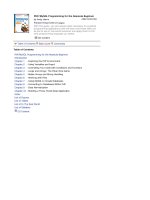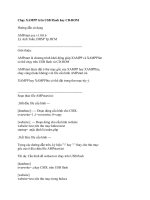PHP 5/MySQL Programming- P76 docx
Bạn đang xem bản rút gọn của tài liệu. Xem và tải ngay bản đầy đủ của tài liệu tại đây (107.34 KB, 5 trang )
value = “$roomNum”>
</td>
</tr>
<tr>
<td></td>
<td>$northList</td>
<td></td>
</tr>
<tr>
<td>$westList</td>
<td>
<textarea rows = 5 cols = 30 name = “description”>$theText</textarea>
</td>
<td>$eastList</td>
</tr>
<tr>
<td></td>
<td>$southList</td>
<td></td>
</tr>
<tr>
<td colspan = 3>
<input type = “submit”
value = “save this room”>
</td>
</table>
</form>
HERE;
function makeList($dir, $current){
//make a list of all the places in the system
353
C
h
a
p
t
e
r
1
0
C
o
n
n
e
c
t
i
n
g
t
o
D
a
t
a
b
a
s
e
s
w
i
t
h
i
n
P
H
P
global $conn;
$listCode = “<select name = $dir>\n”;
$sql = “SELECT id, name FROM adventure”;
$result = mysql_query($sql);
$rowNum = 0;
while ($row = mysql_fetch_assoc($result)){
$id = $row[“id”];
$placeName = $row[“name”];
$listCode .= “ <option value = $id\n”;
//select this option if it’s the one indicated
if ($rowNum == $current){
$listCode .= “ selected\n”;
} // end if
$listCode .= “>$placeName</option>\n”;
$rowNum++;
} // end while
return $listCode;
} // end makeList
?>
</body>
</html>
Generating Variables
After the standard database connection, the code creates a number of variables.
Some of these variables (
$theText, $roomName, and $roomNum) are simplifications of
the associative array. Another set of variables are the result of the
makeList()
function. This function’s job is to return an HTML list box containing the room
names of every segment in the database. The list box is set up so that whatever
room number is associated with the indicated field is the default.
Printing the HTML Code
The central part of the program consists of a large print statement that develops
the HTML code. The code in this case is a large table enclosed in a form. Every field
in the record has a form element associated with it. When the user submits this
form, it should have all the data necessary to update a record in the database.
354
P
H
P
5
/M
y
S
Q
L
P
r
o
g
r
a
m
m
i
n
g
f
o
r
t
h
e
A
b
s
o
l
u
t
e
B
e
g
i
n
n
e
r
The one element the user should not be able to directly edit is the room number.
This is stored in a hidden field. The directional room numbers are encoded in the
list boxes. All other data is in appropriately named text boxes.
Creating the List Boxes
The list boxes require a little bit of thought to construct.
The
makeList() function expects two parameters. The $dir parameter holds the
direction field name of the current list box. The
$current parameter holds infor-
mation about which room is currently selected for this particular field of the cur-
rent record. The data connection handler
$conn is the only global variable. The
variable
$listCode holds the actual HTML code of the list box returned to the
main program.
The function makes a query to the database to request all the room names. Each
name is added to the list box code at the appropriate time with the correspond-
ing numeric value. Whenever the record number corresponds to the current
value of the record, HTML code specifies that this should be the selected item in
the list box.
Committing Changes to the Database
One more program is necessary. The editSegment.php program allows the user to
edit the data. When finished he submits the form, which calls the
saveRoom.php
program. I won’t repeat the screen shot for this program, because the visuals are
unimportant. However, this program actually updates the database with what-
ever values the user has chosen.
<head>
<title>SaveRoom.php</title>
</head>
<body>
<?
//Once a room has been edited by editSegment, this program
//updates the database accordingly.
//connect to database
$conn = mysql_connect(“localhost”, “”, “”);
$select = mysql_select_db(“chapter7”, $conn);
355
C
h
a
p
t
e
r
1
0
C
o
n
n
e
c
t
i
n
g
t
o
D
a
t
a
b
a
s
e
s
w
i
t
h
i
n
P
H
P
$sql = <<<HERE
UPDATE adventure
SET
name = ‘$name’,
description = ‘$description’,
north = $north,
east = $east,
south = $south,
west = $west
WHERE
id = $id
HERE;
//print $sql;
$result = mysql_query($sql);
if ($result){
print “<h3>$name room updated successfully</h3>\n”;
print “<a href = \”listSegments.php\”>view the rooms</a>\n”;
} else {
print “<h3>There was a problem with the database</h3>\n”;
} // end if
?>
</body>
</html>
This program begins with standard data connections. It then constructs an
UPDATE SQL statement. The statement is quite simple, because all the work is done
in the previous program. I then simply applied the query to the database and
checked the result. An
UPDATE statement won’t return a recordset like a SELECT
statement. Instead, it will return the value FALSE if it was unable to process the
command. If the update request was successful, I let the user know and provide
a link to the
listSegments program. If there was a problem, I provide some (not
very helpful) feedback to the user.
Summary
In this chapter you begin using external programs to manage data. You learn how
MySQL can interpret basic SQL statements for defining and manipulating data.
356
P
H
P
5
/M
y
S
Q
L
P
r
o
g
r
a
m
m
i
n
g
f
o
r
t
h
e
A
b
s
o
l
u
t
e
B
e
g
i
n
n
e
r
You create a database directly in the MySQL console, and you also learn how to
build and manipulate databases with SQLyog. You combine these skills to create
an interesting and expandable game.
357
C
h
a
p
t
e
r
1
0
C
o
n
n
e
c
t
i
n
g
t
o
D
a
t
a
b
a
s
e
s
w
i
t
h
i
n
P
H
P
CHALLENGES
1. Add a new room command to the adventure generator. Hint: Think about
how I created a new test in the quiz machine program from chapter 6.
2. Write PHP programs to view, add, and edit records in the phone list.
3. Write a program that asks a user’s name and searches the database for
that user.
4. Create a front end for another simple database.









